 The
Underwater Blues
The
Underwater Blues
The Sea is blue. That's because it absorbs different wavelengths of light differently. Water absorbs red light more effectively than it absorbs blue light. Anyway, without resorting to formulae or Physics text books, the important point to grasp is that the more water there is between you and something, the bluer it will look on film. Also, the deeper you go, the less red light from the sun can get down there and the bluer things will get. Your eyes are excellent at compensating for this, and once you get used to it the colours look fairly normal even at 20 metres. Your film, on the other hand, cannot compensate so distant objects or objects at depth will look very blue unless you provide some illumination of your own. That's where the strobe comes in.
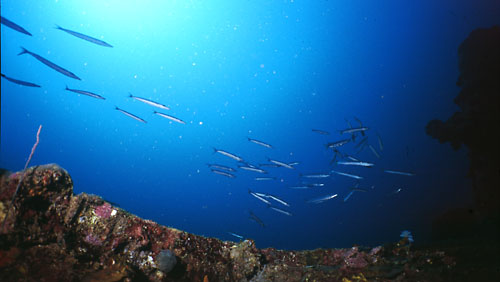 In
this shot the foreground shipwreck is illuminated by the strobe, making
all the colours visible. The fish which have been caught by the strobe
retain their natural colour, but as they get more and more distant they
become bluer. The sunlight in the distance looks cyan instead of white
- the sea acts as a giant cyan filter.
In
this shot the foreground shipwreck is illuminated by the strobe, making
all the colours visible. The fish which have been caught by the strobe
retain their natural colour, but as they get more and more distant they
become bluer. The sunlight in the distance looks cyan instead of white
- the sea acts as a giant cyan filter.
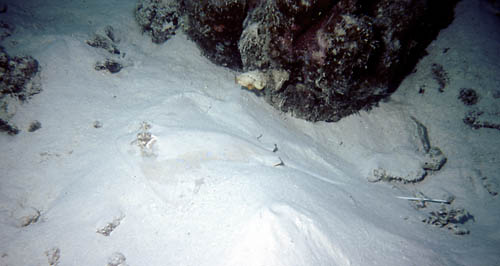 The Stingray
lies camouflaged in the sand. Just enough time to focus, adjust the strobe
angle, calculate the exposure and set the aperture before...
The Stingray
lies camouflaged in the sand. Just enough time to focus, adjust the strobe
angle, calculate the exposure and set the aperture before...
 he
rapidly but gracefully flicks around and glides away.
he
rapidly but gracefully flicks around and glides away.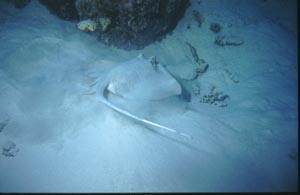 The
images above have been colour corrected in Photoshop. On the left is the
uncropped, un-corrected scan from the Sensia 100ASA side. Projecting a
series of slides in a darkened room, the eyes quickly adjust to the colour
cast, as they do underwater. But to get colours looking the same on screen
or in a print as they did to the diver, some red filtration is needed
to counteract the cyan colour cast.
The
images above have been colour corrected in Photoshop. On the left is the
uncropped, un-corrected scan from the Sensia 100ASA side. Projecting a
series of slides in a darkened room, the eyes quickly adjust to the colour
cast, as they do underwater. But to get colours looking the same on screen
or in a print as they did to the diver, some red filtration is needed
to counteract the cyan colour cast.
Kodak used to make a special underwater film which was much more responsive to red light than other wavelengths. It has since been discontinued, presumably because the film's altered colour balance would only exactly cancel out the cyan colour cast when the subject was at a certain depth and lit in a certain way, making it a very specialised film. With Photoshop we can get the same effect using normal slide film simply by adjusting the "Red" channel with the curves tool, but with the advantage that we can use different amounts of red for each shot to get the correct colour balance each time.
The Macro Universe
 One of
my regrets from my brief underwater photography experience is that I never
really belived the Motormarine's macro attachment would work. It's an
unlikely looking contraption which attaches to the front of the lens and
has a collapsable window frame sort of affair on the end of a stalk. The
window shows you where the camera's point of critical focus is. Depth
of field is very limited with macro shots but because your strobe is practically
touching the subject, there is plenty of light and you can use small apertures
to improve matters.
One of
my regrets from my brief underwater photography experience is that I never
really belived the Motormarine's macro attachment would work. It's an
unlikely looking contraption which attaches to the front of the lens and
has a collapsable window frame sort of affair on the end of a stalk. The
window shows you where the camera's point of critical focus is. Depth
of field is very limited with macro shots but because your strobe is practically
touching the subject, there is plenty of light and you can use small apertures
to improve matters.
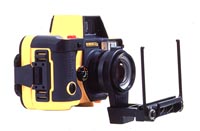
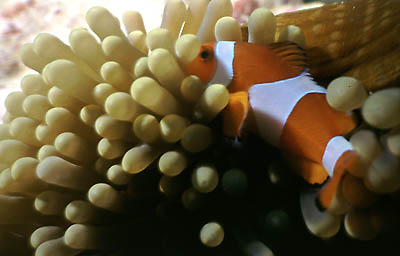 One
pitfall, which I was aware of but largely failed to avoid, results from
the fact that the strobe is mounted to the left of the camera, at an angle.
This is to avoid "back-scatter", which is when particles suspended
in the water are lit up brightly because the strobe is angled parallel
to the lens. It's the underwater equivalent of red-eye. As with red-eye,
it can be eliminated by having the flash away from the lens, to one side
of the camera, angled in towards the subject. For macro shots, however,
the angle is too severe, leading to very obvious shadows such as in the
unfortunate four-legged starfish shot above. The only way to completely
avoid shadows is to have more than one strobe, but the problem can be
reduced if you detatch the strobe from its bracket and hold it closer
to the subject.
One
pitfall, which I was aware of but largely failed to avoid, results from
the fact that the strobe is mounted to the left of the camera, at an angle.
This is to avoid "back-scatter", which is when particles suspended
in the water are lit up brightly because the strobe is angled parallel
to the lens. It's the underwater equivalent of red-eye. As with red-eye,
it can be eliminated by having the flash away from the lens, to one side
of the camera, angled in towards the subject. For macro shots, however,
the angle is too severe, leading to very obvious shadows such as in the
unfortunate four-legged starfish shot above. The only way to completely
avoid shadows is to have more than one strobe, but the problem can be
reduced if you detatch the strobe from its bracket and hold it closer
to the subject.
 I think
despite my decidedly amateur first efforts at underwater macro, I'm really
encouraged to try it again. However, with macro photography probably more
than any other type, good shots depend on critical focus. getting the
clownfish's eye right between those two little rods on the close-up attachment
is never going to be easy. One millimetre too close or too far away from
the lens and your critical focus will be ruined. The really superb underwater
macro shots you see in publications such as the National
Geographic are taken with housed SLR systems.
I think
despite my decidedly amateur first efforts at underwater macro, I'm really
encouraged to try it again. However, with macro photography probably more
than any other type, good shots depend on critical focus. getting the
clownfish's eye right between those two little rods on the close-up attachment
is never going to be easy. One millimetre too close or too far away from
the lens and your critical focus will be ruined. The really superb underwater
macro shots you see in publications such as the National
Geographic are taken with housed SLR systems.
 Weird
blobby stuff with shrimpy thing (blobbius squidga and prawnos ignoramus)
Weird
blobby stuff with shrimpy thing (blobbius squidga and prawnos ignoramus)
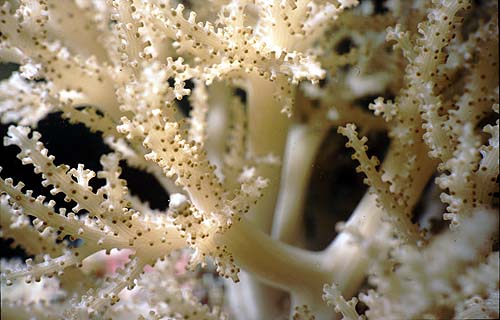 Soft
coral
Soft
coral
| [Home] | [About] | [Order Prints] | [Articles] | [Links] |